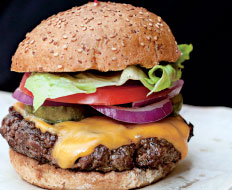Friends since sixth grade, Anthony Ackil and Jon Olinto talked about starting a business together for years. They could only agree on one idea, however, and that was “making fast food real.”
Ackil and Olinto trace their appreciation of “real food” to being fed after school by Ackil’s Uncle Faris, who dispensed both home-cooked meals and advice, often reminding the boys to “be good.”
Eventually, the two created a restaurant concept called b.good with the tagline “real.food.fast.”
Aside from Uncle Faris’s meatballs, lasagna, and grilled chicken, Olinto says, the pair ate a lot of fast-food burgers and fries as kids.
“By the time we were 25, we had more disposable income and we wanted to look better and feel better, but we still wanted to be able to eat burgers and fries,” Olinto says.
The menu at the original b.good, located in Harvard Square in Cambridge, Massachusetts, included not only burgers and fries, but also full dinners and an array of cold sandwiches. By the time the second location opened, the menu had been cut in half.
“The menu being so large was the result of our being scared that someone would want something we didn’t offer,” Olinto says. “We thought we were reducing our risk of failure, but were really making it more complicated and increasing our risk.”
b.good
Cofounders: Anthony Ackil and Jon Olinto
HQ: Boston
Year Started: 2004
Annual Sales: Undisclosed
Total Units: 13
Franchise units: 3
Today, the b.good menu offers fresh ground beef, turkey, or veggie burgers. There’s also a grilled chicken sandwich. Any of these is available as a classic Cousin Oliver with lettuce, tomato, onions, and pickles; a West-Side with avocado, cilantro, fresh salsa, chipotle, and lime; a Buffalo with buffalo sauce, blue cheese, marinated carrots, and celery; an El Guapo with bacon, jalapeño ranch, lettuce, tomato, and onion; or an Adopted Luke with mushrooms, caramelized onions, Gouda, and barbecue sauce.
There are also four salad choices, including Chicken Caesar and Strawberry Goat Cheese. Small versions of the salads are available as sides, along with sautéed crisp veggies or hand-cut fries made from potatoes or sweet potatoes, both oven baked.
Milkshakes, made with ice cream or frozen yogurt, round out the menu.
“People put us in the better-burger category,” Olinto says. “But we don’t belong there. We love burgers and we love the way we make them, so we lead by talking about burgers, but only 15 percent of all sales are beef burgers. We sell a ton of salads and veggie burgers.”
Though b.good serves more female than male customers, Olinto says, its core customers are “both women and men who care about how they look and feel.”
After opening four stores in urban Boston and Cambridge, b.good expanded to the suburbs.
“We didn’t realize how well we’d do with young families until we went out to the suburbs,” Olinto says. “Young moms connect with our mission and see us as a great alternative to fast food. Plus, the suburban stores are busy during different dayparts. At urban stores, we have a huge lunch rush Monday through Friday. In the suburbs, we have more consistent traffic at lunch and dinner, and it spikes on weekends.”
The prototype for a b.good unit is between 2,200 and 2,500 square feet, which provides enough space to store fresh vegetables in the front of the house in open coolers, allowing customers to see employees select fresh produce to make salads.
The per-person check average at b.good is around $10.
“That’s higher than traditional fast food, but in line with fast casual,” Olinto says.
In March 2013, b.good opened its 10th location, which was also the concept’s first franchised location.
Olinto says there are 13 stores now open and 22 additional franchise locations in development, with plans to grow the number of corporate stores, as well. He says 50 total units in five years is a reasonable goal for the burger brand.
“We are focusing on the East Coast and have some interest in the Midwest,” Olinto says.
Originally, Olinto and Ackil defined “real food” as food made by people instead of factories, and that became their mission. That philosophy, however, is constantly evolving.
“When we started, we thought if we would grind the beef and hand-cut the potatoes, that would make it real food,” Olinto says. “As we got into it, we became more passionate about what real food should be. Now it means getting meat from family farms that never use antibiotics or hormones and being transparent about the source of all our ingredients.”
As the chain of burger restaurants grew, Olinto and Ackil formed strong and lasting relationships with suppliers and started telling their stories. Signs posted in each restaurant educate customers about who supplies the meat and vegetables that are served in that particular restaurant.
All b.good veggie burgers, sauces, and dressings are made from scratch with whole, natural ingredients, and the restaurants use produce from local farms, rotating some menu items based on seasonal and local availability.
The concept works with a cooperative network of beef farms spread out from Maine to Florida, and Olinto says the bigger demand being created by b.good’s growth has farmers excited.
“We couldn’t have the relationship with some of the farms that we do if we couldn’t commit to them,” he says. “Our growth and commitment to them have allowed some of them to invest in their businesses and expand.”
Despite its focus on transparently presenting all ingredients and nutritional information to guests, b.good doesn’t make any
health claims.
“Healthy is a polarizing word, and what people consider healthy changes every day,” Olinto says. “Real food is just food you don’t mess with.”








